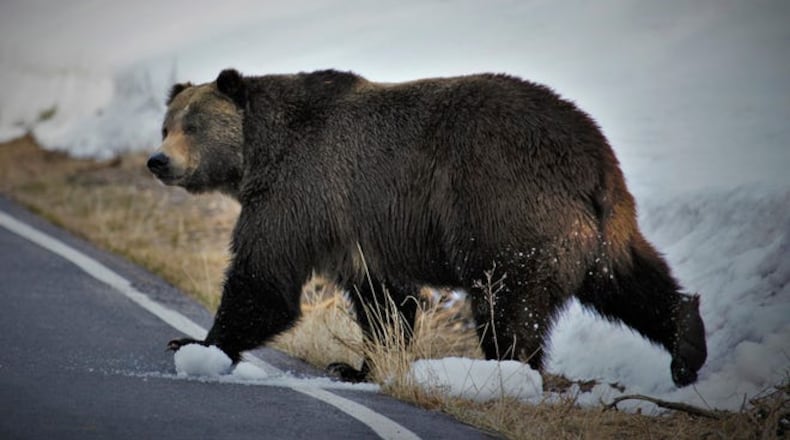A backcountry guide who was fishing just west of Yellowstone National Park in Montana last week was fatally attacked by a large grizzly bear that might have been protecting a food source, park and law enforcement officials said Monday.
The attack took place near the Baker’s Hole campground in an area about 3 miles north of West Yellowstone, Montana, according to Morgan Jacobsen, the spokesperson for Montana Fish, Wildlife and Parks.
The victim, Charles W. Mock IV, 40, of West Yellowstone, was carrying a fishing pole and bear mace when he was attacked Thursday afternoon by what Jacobsen described as a large older male grizzly bear. Mock called 911 for help. Emergency responders arrived in about 50 minutes and saw the bear, Jacobsen said.
Mock was taken to Idaho Falls for treatment of severe injuries, Montana Fish, Wildlife and Parks said in a statement. He died of his injuries Saturday, authorities said.
On Friday, Montana park officials sent seven game wardens and bear specialists to investigate the area where Mock was attacked. Believing the bear that mauled him might still be in the area, the group proceeded cautiously.
“They yelled and made continuous noise as they walked” to scare any bears away, a process referred to as hazing, park officials said in the statement. Then, they saw the bear. And it charged at the group.
“Despite multiple attempts by all seven people to haze away the bear, it continued its charge,” park officials said.
The bear was shot and died about 20 yards from the group, officials said. Later, officials found what they believe might have been the source of the bear’s behavior: a moose carcass cached about 50 yards from where Mock was attacked.
“Bears and grizzly bears in particular are very protective of their food source once they’ve claimed it,” Jacobsen said. “If they feel that that claim is under threat, they will defend it and they’ll stay nearby.” The bear’s behavior Friday and its proximity to the initial attack, he said, “made us certain that this is the same bear.”
In Idaho, Mock underwent two surgeries that went well, according to a Facebook post from his employer, Backcountry Adventurers, which provides snowmobile rentals and tours of the park. But Saturday, the Gallatin County Sheriff’s Office in Montana announced that Mock had died at East Idaho Regional Medical Center.
Backcountry Adventures said Mock had “suffered a massive stroke.” His death “comes as a terrible shock and is heartbreaking,” the company wrote. The money raised on a GoFundMe page — $29,000 as of Monday evening — will go to Mock’s family for medical and funeral expenses, the company said.
According to the National Park Service: “Since 1979, Yellowstone has hosted over 118 million visits. During this time, 44 people were injured by grizzly bears in the park.”
Grizzly bears in the continental United States are listed as threatened under the Endangered Species Act. That designation means it is illegal to “harm, harass, or kill these bears, except in cases of self-defense or the defense of others,” according to the U.S. Fish and Wildlife Service.
In 2017, the U.S. Fish and Wildlife Service removed those protections for grizzly bears when it took them off the endangered list. In 2018, a federal court forced the agency to put grizzly bears back on the list. And in 2020, a federal appeals court in San Francisco upheld that lower court’s ruling, protecting approximately 700 grizzly bears living in the Greater Yellowstone Ecosystem, which includes 34,000 square miles in parts of Montana, Idaho and Wyoming.
About 50,000 grizzly bears once roamed North America. When they were placed on the endangered species list in 1975, there were only a few hundred left. Today, “we have a growing grizzly bear population in the Greater Yellowstone Ecosystem,” Jacobsen said. The site where Mock was attacked is “fairly close to that epicenter of growth,” he said.
Because of that growth, “we are seeing grizzly bears expand into areas where they haven’t been in a long time,” Jacobsen said. And at the same time, he added, there is “increased residency and visitation to some of these areas in southwest Montana.” Those two trends, he said, “set things up to produce more encounters between humans and grizzly bears.”
Jeremy Kopp, undersheriff in Gallatin County, referred to the Greater Yellowstone Ecosystem simply as “grizzly country.” In a brief interview Monday evening, he warned people in the area to be alert, especially around this time of year. Grizzly bears “spent a long winter in hibernation,” he said, adding, “Now they’re out and slowly coming back to life and feeding.”
About the Author
The Latest
Featured
